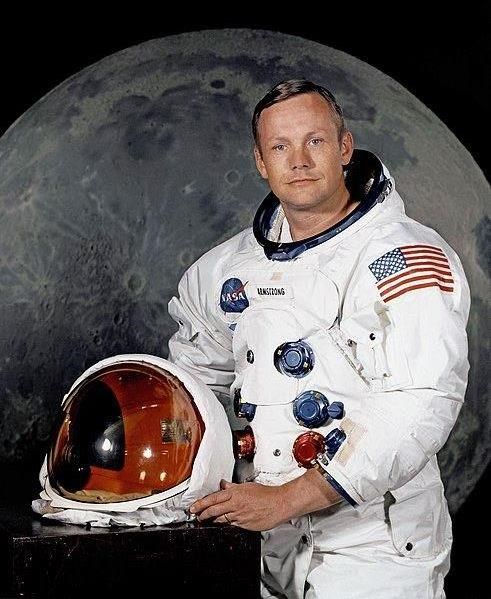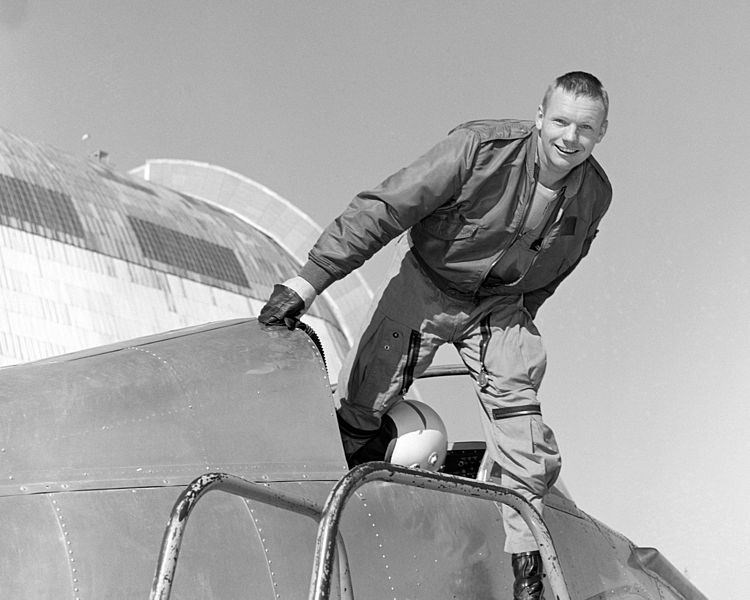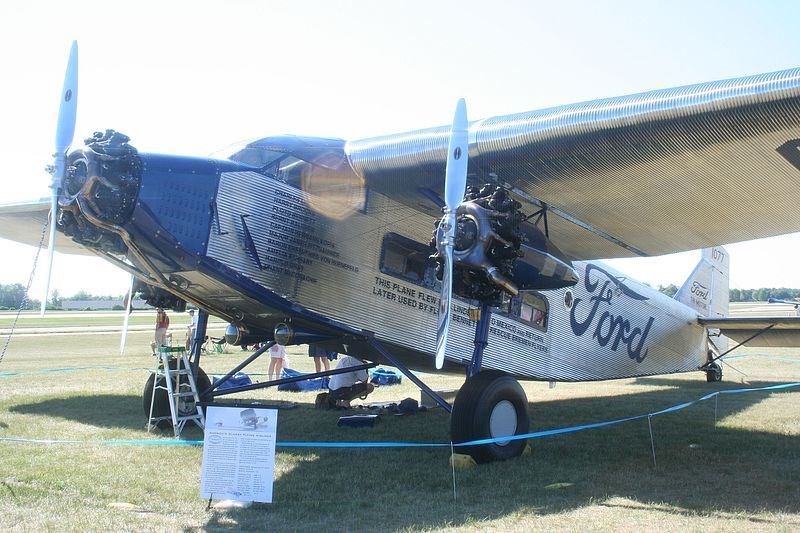 Neil Armstrong posing in his spacesuitNASA Photo ID: S69-31741 - Program: Apolo XI [Public domain]Just as the roar of the engines begin to die down, a light bump can be felt throughout the cockpit. After suiting up, the inhabitants depressurize the capsule and open the hatch. There is no sound, no oxygen, and no life. The surrounding world is barren. One of the explorers descends down a ladder and places his foot on the gray soil below him. “One small step for man, one giant leap for mankind,” Neil Armstrong communicated back with Mission Control. The astronaut, once test pilot, once aircraft enthusiast, has finally completed the mission that he was destined to complete. Ever since Neil was a toddler, he was fascinated by airplanes and made it his dream to one day have a career in aeronautics. At the age of sixteen, Armstrong earned his pilot’s license before he could drive (Donovan). “In 1947, Armstrong began his studies in aeronautical engineering at Purdue University on a U.S. Navy scholarship” (History.com). He was called to active duty while he was at university and flew 78 combat missions and earned three medals for his heroic actions. After finishing school, Neil Armstrong became a test pilot. An occupation many would be too afraid to pursue. Neil Armstrong at first didn’t want to join NASA: “He'd been initially unimpressed with NASA's Mercury program, but after John Glenn's orbital flight in 1962, he changed his mind and applied to be an astronaut.” Later in life, he joined NASA and was selected to command the first manned flight to the moon. Neil Armstrong wasn’t only courageous, he was also determined. These traits led to him to becoming an astronaut and landing on the moon.
Neil Armstrong posing in his spacesuitNASA Photo ID: S69-31741 - Program: Apolo XI [Public domain]Just as the roar of the engines begin to die down, a light bump can be felt throughout the cockpit. After suiting up, the inhabitants depressurize the capsule and open the hatch. There is no sound, no oxygen, and no life. The surrounding world is barren. One of the explorers descends down a ladder and places his foot on the gray soil below him. “One small step for man, one giant leap for mankind,” Neil Armstrong communicated back with Mission Control. The astronaut, once test pilot, once aircraft enthusiast, has finally completed the mission that he was destined to complete. Ever since Neil was a toddler, he was fascinated by airplanes and made it his dream to one day have a career in aeronautics. At the age of sixteen, Armstrong earned his pilot’s license before he could drive (Donovan). “In 1947, Armstrong began his studies in aeronautical engineering at Purdue University on a U.S. Navy scholarship” (History.com). He was called to active duty while he was at university and flew 78 combat missions and earned three medals for his heroic actions. After finishing school, Neil Armstrong became a test pilot. An occupation many would be too afraid to pursue. Neil Armstrong at first didn’t want to join NASA: “He'd been initially unimpressed with NASA's Mercury program, but after John Glenn's orbital flight in 1962, he changed his mind and applied to be an astronaut.” Later in life, he joined NASA and was selected to command the first manned flight to the moon. Neil Armstrong wasn’t only courageous, he was also determined. These traits led to him to becoming an astronaut and landing on the moon.
 Neil Armstrong climbing out of a Bell X-14 experimental aircraftNASA Photographer Lee Jones [Public domain]Neil Armstrong’s Courage allowed him to do what he set his mind to even though he knew the dangers and possible negative outcomes of his actions. This is evident when he joined the military and became a test pilot. When Neil went to Purdue University, he went on a Navy scholarship and while studying aeronautical engineering, he was called to active duty: “His studies, however, were interrupted in 1949 when he was called to serve in the Korean War. A U.S. Navy pilot, Armstrong flew 78 combat missions during this military conflict. He left the service in 1952, and returned to college” (History.com Editors). Joining the military is not something that everyone is brave enough to do, so when Armstrong served in the Navy in exchange tuition, it shows courage. During two of his missions, Armstrong’s aircraft were severely damaged and he was able to either bail out or return to his aircraft carrier. Neil’s actions shows courage because during those 78 combat missions, Neil remained calm and focused and completed his objectives. Furthermore, Neil Armstrong has proved his capabilities when he experienced a dire situation in space: “It was during Gemini 8 that NASA experienced its first emergency in space. About thirty minutes after docking, the joined crafts began to roll. To prevent damage to both the space capsule and the satellite, the two craft separated” (Wyborny 49). When Neil Armstrong was put in a life or death situation, Neil remained calm and chose life. Most people when placed in a similar situation would most likely freak out and end themselves, but Armstrong was able to believe in his training and execute a procedure and saved the lives of himself and his crew mate. Neil Armstrong showed bravery and courage and in doing so, fought for our country and fought for his life.
Neil Armstrong climbing out of a Bell X-14 experimental aircraftNASA Photographer Lee Jones [Public domain]Neil Armstrong’s Courage allowed him to do what he set his mind to even though he knew the dangers and possible negative outcomes of his actions. This is evident when he joined the military and became a test pilot. When Neil went to Purdue University, he went on a Navy scholarship and while studying aeronautical engineering, he was called to active duty: “His studies, however, were interrupted in 1949 when he was called to serve in the Korean War. A U.S. Navy pilot, Armstrong flew 78 combat missions during this military conflict. He left the service in 1952, and returned to college” (History.com Editors). Joining the military is not something that everyone is brave enough to do, so when Armstrong served in the Navy in exchange tuition, it shows courage. During two of his missions, Armstrong’s aircraft were severely damaged and he was able to either bail out or return to his aircraft carrier. Neil’s actions shows courage because during those 78 combat missions, Neil remained calm and focused and completed his objectives. Furthermore, Neil Armstrong has proved his capabilities when he experienced a dire situation in space: “It was during Gemini 8 that NASA experienced its first emergency in space. About thirty minutes after docking, the joined crafts began to roll. To prevent damage to both the space capsule and the satellite, the two craft separated” (Wyborny 49). When Neil Armstrong was put in a life or death situation, Neil remained calm and chose life. Most people when placed in a similar situation would most likely freak out and end themselves, but Armstrong was able to believe in his training and execute a procedure and saved the lives of himself and his crew mate. Neil Armstrong showed bravery and courage and in doing so, fought for our country and fought for his life.
 A Ford 4AT Trimotor, the first plane Neil Armstrong flew inBzuk [Public domain]Neil Armstrong’s determination allowed him to keep moving forward even after failing and nearly dying. Ever since he was a toddler, Neil was fascinated by airplanes: “As a small child, Neil was mesmerized by airplanes. His father, Stephen, took him to the airport when Neil was a toddler. Two-year-old Neil stood quietly and watched the airplanes take off and land, captivated by what he saw” (Wyborny 43). This is an important period during his life because as Neil grew older he became more and more obsessed with aircraft. He was so obsessed that he spent every dollar he made on buying bigger and better models. Armstrong even built a laboratory: “He took his hobby seriously, even to the point of building a wind tunnel in the basement to test the aerodynamic properties of some of his larger models” (Wyborny 45). This shows Neil’s interest in aircraft engineering. He was so interested that he built a wind tunnel in his basement despite not having a lot of money or having the proper credentials. His determination was so great that he didn’t wait until graduation to pursue his dreams. Neil Armstrong also showed his determination by choosing his occupation: “His numerous brushes with death did not make him afraid of further travel in space. He once said, ‘I have been in relatively high-risk businesses all of my adult life... I have confidence in the equipment, the planning, the training’” (“Neil Armstrong”). Neil knew the dangers of being a pilot and an astronaut. He almost died many times from being a test pilot and continued to test fly. He experienced an emergency in space and continued with his NASA career. The risk was almost always greater than the reward and he took the chance and went home with the prize.
A Ford 4AT Trimotor, the first plane Neil Armstrong flew inBzuk [Public domain]Neil Armstrong’s determination allowed him to keep moving forward even after failing and nearly dying. Ever since he was a toddler, Neil was fascinated by airplanes: “As a small child, Neil was mesmerized by airplanes. His father, Stephen, took him to the airport when Neil was a toddler. Two-year-old Neil stood quietly and watched the airplanes take off and land, captivated by what he saw” (Wyborny 43). This is an important period during his life because as Neil grew older he became more and more obsessed with aircraft. He was so obsessed that he spent every dollar he made on buying bigger and better models. Armstrong even built a laboratory: “He took his hobby seriously, even to the point of building a wind tunnel in the basement to test the aerodynamic properties of some of his larger models” (Wyborny 45). This shows Neil’s interest in aircraft engineering. He was so interested that he built a wind tunnel in his basement despite not having a lot of money or having the proper credentials. His determination was so great that he didn’t wait until graduation to pursue his dreams. Neil Armstrong also showed his determination by choosing his occupation: “His numerous brushes with death did not make him afraid of further travel in space. He once said, ‘I have been in relatively high-risk businesses all of my adult life... I have confidence in the equipment, the planning, the training’” (“Neil Armstrong”). Neil knew the dangers of being a pilot and an astronaut. He almost died many times from being a test pilot and continued to test fly. He experienced an emergency in space and continued with his NASA career. The risk was almost always greater than the reward and he took the chance and went home with the prize.
By believing in himself and never giving up, Neil Armstrong was able to reach great heights. Neil is an inspiration because despite growing up in a poor family, reaching for the stars allowed him to go far in life. He was always humble when talking about his accomplishments, and worked hard to succeed. Since he was at a young age, he was determined to fly: “Born in a small-town Ohio farmhouse, Armstrong had earned his student pilot's license on his 16th birthday and soloed a few weeks later, all before he learned to drive a car” (Donavan). This shows that Neil Armstrong was interested in flight and aeronautics from a young age. When a child becomes passionate for something at a young age and this passion carries on until adulthood, that child will most likely do great things relating to the thing that they’re passionate about. Ever since his military career, Neil has shown modesty: “Armstrong flew seventy-eight combat missions and in the process accumulated three air medals. Still not one to showcase his accomplishments, Armstrong was modest when asked about the awards years later, saying, ‘They handed out medals like gold stars at Sunday school’” (Wyborny 46). Fighting for our country is a courageous act and despite his plane being badly damaged twice, Neil Armstrong continued to fly. Doing so earned him three medals, and being modest he didn’t act like they defined him. It’s usually the people who make the biggest impact that talk about their actions the least. If you want to go to a college or get hired for a job or run a four minute mile, all you have to do is be determined. Neil Armstrong knew this and that is the main reason why he was so successful. If you figure out how to unlock your determination and courage, then you may find yourself in a pressurized suit, perhaps on a red, barren wasteland.
Page created on 4/8/2019 9:13:03 PM
Last edited 7/2/2025 4:20:43 PM
Donovan, James. "Before the Moon Landing: How Neil Armstrong Saved NASA; Armstrong made his 'historic leap for mankind' when he walked on the moon on July 20, 1969. But three years earlier, he'd performed another, salvaging a mission that could have derailed the space program." Newsweek, 22 Mar. 2019. Biography In Context, https://link.galegroup.com/apps/doc/A579071065/BIC?u=powa9245&sid=BIC&xid=19c05419.
Editors, History.com. “Neil Armstrong.” History.com, A&E Television Networks, 4 Sept. 2018,www.history.com/topics/space-exploration/neil-armstrong.
"Neil Armstrong." Contemporary Heroes and Heroines, vol. 1, Gale, 1990. Biography In Context, https://link.galegroup.com/apps/doc/K1607000015/BIC?u=powa9245&sid=BIC&xid=08dbadfd. Wyborny, Sheila. Astronauts. Lucent Books, 2001
